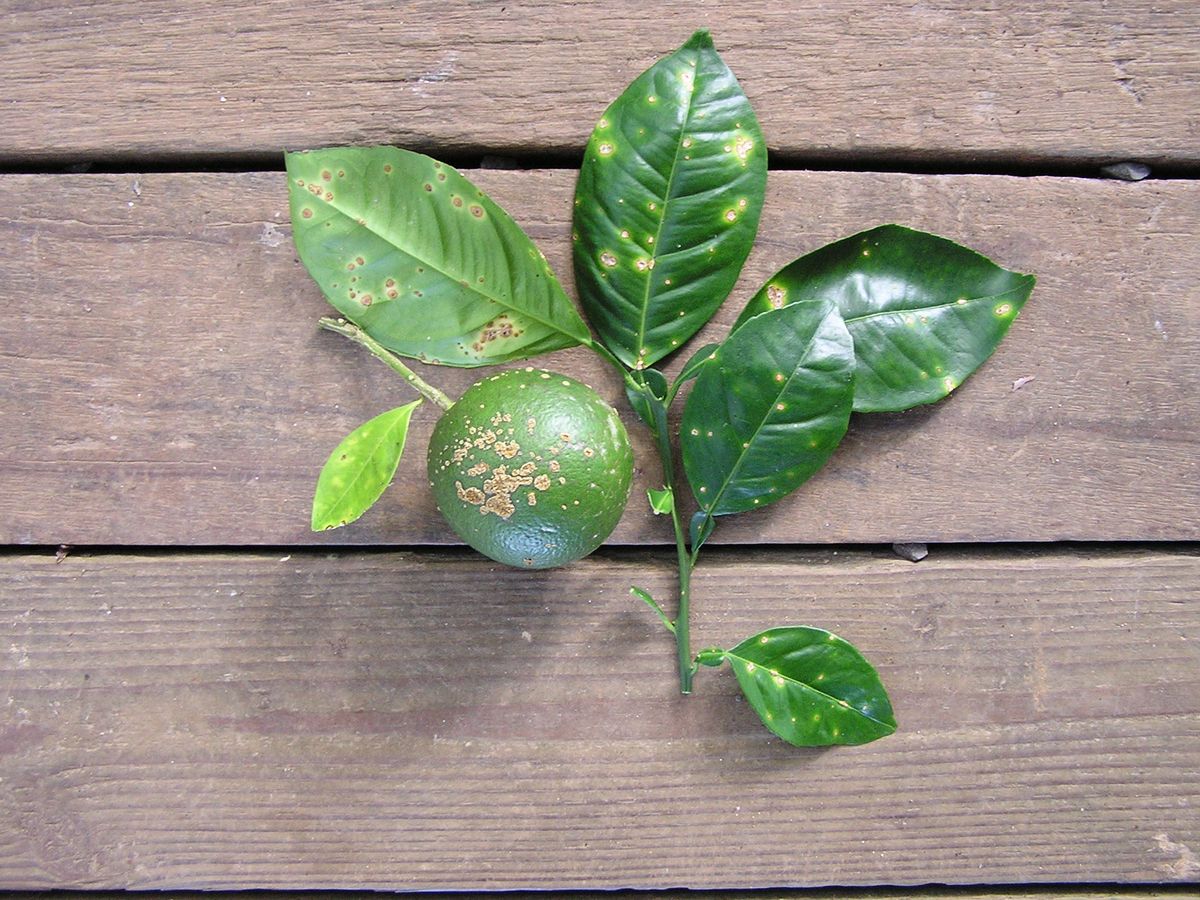Citrus Canker Treatment and Prevention
As a person with citrus plants, it is essential to be knowledgeable about citrus canker and implement preventative actions to protect your trees. By staying informed and taking the necessary steps, you can contribute to safeguarding the health of citrus trees in your area.

Citrus canker is a bacterial disease that poses a significant threat to the citrus industry, particularly in Florida, which has a $9 billion citrus market. The bacterium Xanthomonas citri subsp. citri causes this disease, affecting citrus trees' vitality by causing leaves and fruit to drop prematurely. Infected plants display characteristic lesions on leaves, stems, and fruit, with raised, brown, water-soaked margins often surrounded by a yellow halo.
Treatment and prevention of citrus canker involve preventive measures and chemical control methods. Since eradicating the disease in 1933, after spending $6.5 million, the management of citrus canker has primarily relied on copper-based bactericides. These chemical treatments help reduce the disease's spread and protect healthy trees from infection.
Understanding Citrus Canker
Symptoms
Citrus canker is a plant disease that affects citrus trees, causing distinct lesions on leaves, stems, and fruit. These lesions often begin as small, blister-like spots with raised, brown, water-soaked margins and a characteristic yellow halo around them. The lesions may become corky as the disease progresses, often retaining the yellow halo effect.
Causes
The leading cause of citrus canker is the bacteria Xanthomonas citri, which can significantly impact the vitality of citrus trees such as lemon, grapefruit, and lime. While not harmful to humans, the disease reduces fruit marketability due to the unsightly appearance of the affected fruit. Proper treatment and prevention measures are crucial to protect the citrus industry from this devastating disease.
Affected Hosts
Citrus canker targets many trees, including lemon, grapefruit, and lime. The disease can cause leaves and fruit to drop prematurely, resulting in lost harvests and financial burdens for citrus growers. By recognizing the symptoms, understanding the causes, and taking preventive steps, you can help protect your citrus trees from the damaging effects of citrus canker.
Spread of Citrus Canker
Natural Conditions
Natural conditions, such as rain, wind, and hurricanes, can significantly influence the spread of citrus canker. These factors can cause the disease to travel long distances and affect new areas. Rain and wind can disperse the bacteria through the air, while hurricanes lead to more widespread distribution.
Human-Mediated Factors
Human activities also play a significant role in the spread of citrus canker. For example, interstate movement of contaminated plants or plant material can introduce the disease to previously unaffected regions. Additionally, improper pruning practices in dooryard settings can cause the infection to spread from one tree to another. To minimize the risk of contamination, it's crucial to follow proper planting, maintenance, and hygiene practices.
Treatment and Management
Eradication Methods
Citrus canker is a bacterial disease that affects the vitality of citrus trees, causing leaves and fruit to drop prematurely. To manage this disease, it's essential to implement preventive measures and eradication methods. One effective approach is using copper-based bactericides, which are applied in combination with cultural practices such as pruning and defoliation of diseased summer and fall shoots.
Another critical aspect of managing citrus canker is a stringent quarantine and decontamination process. By limiting the spread of the disease, you can protect your citrus trees and minimize the need for tree removal. The eradication program should focus on early detection, monitoring, and removal of infected trees to prevent further disease spreading.
Biocontrol Citrus Biocontrol
In addition to chemical treatments and eradication methods, biocontrol techniques can also be used to manage citrus canker effectively. One such method involves controlling the Asian Citrus Psyllid, a vector for transmitting citrus greening disease. By introducing Tamarixia, a natural parasitoid of the Asian Citrus Psyllid, you can significantly reduce the psyllid population, thus limiting the spread of the disease.
Implementing these treatment and management techniques can help maintain the health of your citrus trees. Combining preventive measures, eradication methods, and biocontrol strategies will provide a more viable and comprehensive approach to combating citrus canker disease.
Conclusion
Citrus canker is a bacterial disease that significantly affects the vitality of citrus trees, causing premature leaf and fruit drop. To prevent and manage citrus canker, it's essential to stay informed about the disease and implement best practices for its control. Quarantine measures, regular monitoring, and the removal of infected plants are crucial strategies for containing the spread of this disease.
Using resistant citrus varieties is an effective and eco-friendly method to control citrus canker. However, developing these varieties can be time-consuming and not widely available. In the meantime, exploring alternative ways, like biocontrol, can help manage the disease.
Remember that preventing the spread of citrus canker is a collective effort. By following recommended practices, communicating with local agricultural authorities, and staying updated on citrus canker developments, you can contribute to the overall health of citrus trees in your community.
Frequently Asked Questions
What are the most effective treatments for citrus canker?
There is no cure for citrus canker, but treatments focus on management to minimize its impact. Pruning infected branches and leaves during the dry season can help, as it reduces the chances of bacterial spread. Additionally, using copper-based bactericides following the label instructions can aid in controlling the disease.
How can you prevent citrus canker from spreading?
To help prevent citrus canker from spreading, adopt good sanitation practices, such as sanitizing your tools between uses and avoiding wet conditions when working with your citrus trees. If possible, choose resistant citrus varieties when planting new trees. Be aware of USDA quarantine regulations to prevent the movement of infected material across state lines.
What role do biological controls play in managing citrus canker?
Biocontrol agents, such as beneficial bacteria, may help suppress citrus canker, but further research is needed to assess their effectiveness. Since no effective biocontrols are currently available, stick to the recommended management practices, including pruning, proper sanitation, and use of resistant varieties, to control the spread of citrus canker.
Are humans at risk from citrus canker?
Citrus canker is not harmful to humans. The bacterium responsible for Xanthomonas citri subsp. citri affects only citrus trees and poses no direct risk to human health. However, it can significantly impact the citrus industry by causing premature leaf and fruit drop in infected trees.
What are the common symptoms of citrus canker on leaves?
Citrus canker symptoms often appear on infected plants' leaves, fruit, and twigs. On leaves, they may initially present as small, blister-like lesions that expand as they age. These lesions can become raised, yellow, or brown, with a water-soaked margin and a yellow halo.


